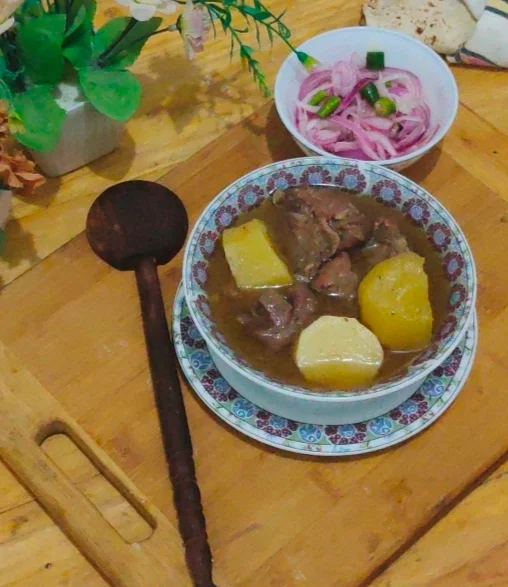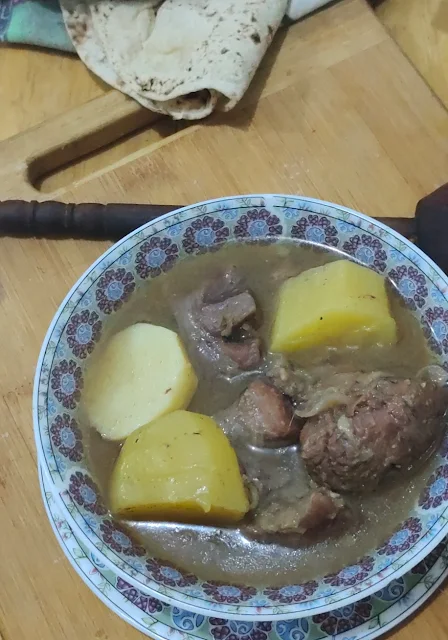Authentic Beef Rosh Recipe || Afghani Beef Rosh || How to Make Beef Rosh with step-by-step photos and Video
Rosh or Namkeen Gosht is a traditional non-vegetarian recipe that's part of the Peshawar and Balochistan cuisines. Traditionally, this recipe is prepared with lamb, salt, fat, and potato in a clay pot on a slow flame. Still,
Here I made this Rosh with a beef bone,nali (marrow) bone, a little ghee (add desi ghee if possible), whole gram masala, onion, lemon juice, ginger, garlic water, potato, and green chilies. The method of this recipe is to cook it on a slow flame until it is tender.
Personally, I am the biggest fan
of Peshawari cooking. I have also shared recipes on my blog, such as PESHAWARI CHAPLI KABAB, NAMKEEN GOSHT, and KABULI PULAO.
Recipe
Notes:
Beef: Traditionally, Rosh is prepared with lamb, but can
be made with mutton and beef as a choice, except for chicken and fish
Bones: I used big-sized nali (marrow) bones, bones always make
juicy and tasty to any non-veg dishes. Don’t skip using bones if you want to
eat the flavored dish.
Ginger Garlic Water: Usually, ginger garlic
isn’t added in this recipe, but here I used some ginger garlic water to remove
the unpleasant odor of the meat. If you are okay with this, then the ginger garlic water can be skipped.
Green Chili: I added some bullet green chilies to
bring some flavor; here, you can skip this if you are just crazy about authentic
taste
Whole Spices: I added some whole
spices to add some aroma. Originally, whole spices weren’t added in authentic
Rosh recipes. It's up to you to use them in the recipe or skip them.
Onion: I added ½ pcs of medium-sized onion so that
some thickness remains in the gravy of Rosh; otherwise, its gravy consistency
will remain thin
Potato: The potato is the main ingredient of the Rosh recipe.
Here I used red potatoes, which are the best for the recipe. Don’t use seasonal
potato (naya also) as it is soft and quickly cooks, causing a spoiled Rosh
taste after being mixed with the meat.
Salt: Salt is the only main ingredient added
to Rosh in the original recipe. Here, I used Lahori salt. I would also recommend
using pink salt or Lahori salt, except for refined or sumandari namak (sea salt), which is sharp in taste.
Lemon Juice: Lemon juice is also the main ingredient of
this recipe. This juice is added to Rosh to taste and for digestion. Since
lemon has an acidic property. That helps to quickly digest food without making
gas in the belly and prevents indigestion.
Ghee/Fat: An authentic Rosh recipe uses fat from
lamb, mutton, or beef, but here I add desi ghee instead of adding fat, as we
aren’t used to eating fat in our food. Even then, you want an authentic taste
that can use fat in the recipe. Additionally, I would recommend using desi ghee
(pure ghee)
Clay Pot: Originally, Rosh isn’t cooked in a clay pot; rather, it is cooked in a heavy-bottomed pot on slow heat for a long
time. But I personally like cooking in clay pots to bring an earthly taste to
recipes. I didn’t cook in my recipe since I do not have enough large-sized clay pots, so I decided to cook in a pressure cooker. You choose a pot of your choice, but
one thing to keep in mind is that the base should be heavy with Patella.
If you have tried this Beef Rosh, don’t forget to rate the recipe. You can also follow me on social media to see what’s latest in my kitchen!
Like Our Videos? Then, follow
and subscribe to us
on YouTube to get the latest Recipe Video updates.
How to
make Beef Rosh:
Wash all the meat under
the water, peel, and cut the potatoes into big cubes size
In a pressure cooker, add ghee and heat it. Add the meat and start roasting it with the ghee until its own water evaporates. This method helps eliminate the meat odor.
Keep stirring by adding
cinnamon, black cardamom, black peppercorns, cloves, green cardamom, onion,
and salt.
Stir a little at this stage, can adjust the salt, and check the gravy consistency. If it seems runny, turn the flame high for a while. Occasionally, keep checking in between so that the gravy doesn’t dry.
Rosh or Namkeen gosht is a traditional non-veg recipe that is one of the Peshawar and Balochistan cuisines.
Ingredients:
- 2 kg, beef bong
- Salt to taste
- 100g, ghee/fat
- 2naili (marrow) bones
- 1/2 pcs onion
- 1 cup ginger garlic water
- 1 pod, black cardamom
- 1/2 inch, cinnamon stick
- 2 cloves
- 2 pods of green cardamom
- 2 pcs, green chilies optional
- 300g potato, peeled
- 1 tsp lemon juice
How to
Make Beef Rosh?
Preparation of Beef Rosh: wash all the meat under water, peel, and cut the potatoes into big cubes
Cooking Beef Rosh: In a pressure cooker, add ghee and heat it. Add the meat and start roasting it with the ghee until its own water evaporates. This method helps eliminate the meat odor. Keep stirring by adding cinnamon, black cardamom, black peppercorns, cloves, green cardamom, onion, and salt.
Continuously keep
stirring by adding lemon juice and ginger-garlic water. Stir a little, then add
hot water along with the bones. Bring it to a boil and add green chilies and
potato chunks. Let it cook on a slow flame for 2 hours.
Once cooked, take the
potatoes out on another plate and stir a little at this stage. Adjust the
salt and check the gravy consistency. If it seems runny, turn the flame high for
a while. Occasionally, keep checking in between so that the gravy doesn’t dry. Place the potatoes back into the pan. Now, there's no need to simmer
Transfer and Serving: transfer into
the serving bowl and serve with TAWA NAAN OR TANDOORI ROTI
*Not to be duplicated, rewritten, or published
without permission- Thank you!













.JPG)




Have you any doubts about this blog kindly let me know
EmoticonEmoticon